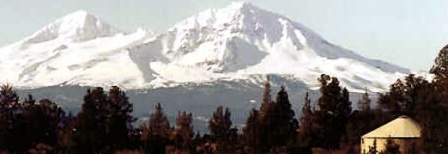 BEND, Ore. (AP) -- It's becoming easier and easier for yurt fans to become yurt campers in Central Oregon.
BEND, Ore. (AP) -- It's becoming easier and easier for yurt fans to become yurt campers in Central Oregon.
Yurt built by Pacific Yurts at the Three Sisters Wilderness in Oregon
Three new yurts are planned for the Link Creek Campground in the Deschutes National Forest. These join the yurts built last fall and opened over the winter at Crescent Lake Campground farther south. Counting the two winter-only yurts available through Three Sisters Backcountry, Inc. and the seven for rent at Tumalo State Park, the new yurts bring the Central Oregon total to 15.
``Everybody, basically, is looking for some sort of retreat or place to get away, and the yurt really fills the bill,'' said Alan Bair, the president and founder of Pacific Yurts in Cottage Grove.
Bair's company sold the new yurts to the Deschutes National Forest and has supplied state and national campgrounds in Oregon with more than 190 yurts over the years.
``When people discover (yurts) in their state or national parks, they come back for more, and that is creating profitability for our parks system, which is sorely needed,'' Bair said.
Mark Christiansen, the recreation program manager for Deschutes and Ochoco National Forests, said the Crescent Lake yurts had been filled for 90 percent of the winter weekends for the 2009-10 season, and he hoped the occupancy rates would go up in the summer months.
``It's kind of a test,'' Christiansen said. ``Yurts are very popular and are in very high demand, so we thought we would try a few of those in our campgrounds to increase use and visitation in the shoulder seasons when the weather is not that nice.''
Yurts are round structures, usually built on a wooden platform that can be put up in less than a day and yet still provide adequate protection from the elements. The new yurts at the Crescent Lake and Link Creek campgrounds are, or will be, 16 feet in diameter and sleep five people. They have a futon that folds down into a double bed, a bunk bed with a double on the bottom and a single on the top, a wood stove and a kitchen table. Some chairs and a side table are provided as well. The forest service is in the process of adding wheelchair-accessible ramps to the Crescent Lake yurts and plans to do the same for the Link Creek yurts when they are built this summer.
Other than a tent and a sleeping mat, yurt dwellers must bring everything else they might need to camp. Sleeping bags or sheets and blankets, cooking utensils and a camp stove, for example, are a must.
Christiansen said the Crescent Lake and Link Creek campgrounds were chosen for the yurt experiment mainly because of their accessibility in winter. In the summer, there is drive-up access, but even in the winter both areas offer parking less than 300 yards from the yurts. Plus, cross- country skiing and snowshoeing opportunities abound, Christiansen said. Ice fishing also is available at the Crescent Lake site in the winter for those with proper equipment. Also, last winter, the staff at Crescent Lake Resort, which manages the yurts, offered to haul campers' gear to the yurts for no extra charge.
The yurts in the Deschutes National Forest come especially equipped for snow and high winds, according to Bair. The wall is a high-tech architectural canvas, Bair said. It is leak-proof and guaranteed for 15 years. Each yurt also comes with a standard issue skylight, Bair said, providing natural light year round.
Altogether, including labor, Christiansen said each yurt cost about $15,000. At $30 per night in the summer and $40 per night in the winter, the yurts could pay for themselves in just five years, even if they were only rented on the weekends.
Christiansen said the forest service had ``tailored (the yurt project) after what the Oregon state parks have done.'' He added, ``what we have heard through the state parks is that their yurts are the first to be reserved and filled.''
Susan Bethers, park manager of Tumalo State Park in Bend, confirmed that the seven yurts at the Tumalo campground are usually the first to fill. It's nearly impossible, she said, to show up in the summer and get a yurt without making a reservation in advance. ``Everybody really likes them,'' Bethers said. ``I think they're unique, and yet they're easy because you don't have to pitch your tent so it makes camping pretty easy.''
There used to be yurts available at La Pine State Park as well, but there are none there now according to Joe Wanamaker, the park manager. ``It was before my time,'' he said, ``but from my understanding, the winters were too cold for the yurts.'' Wanamaker said he believed the switch to cabins -- six are offered -- was made in 2004.
Christiansen does not foresee adding more yurts to Deschutes or Ochoco campgrounds any time soon, but said the forest service recreation program would await public feedback. He said yurts fill a niche for people who want to commune with the outdoors but also be surrounded by something firmer than tent walls.
As Bair put it, ``it's the unique experience -- the round, the skylight, the fact that you're close to nature, but still protected and warm and comfy.''






















































































































































































































































































































